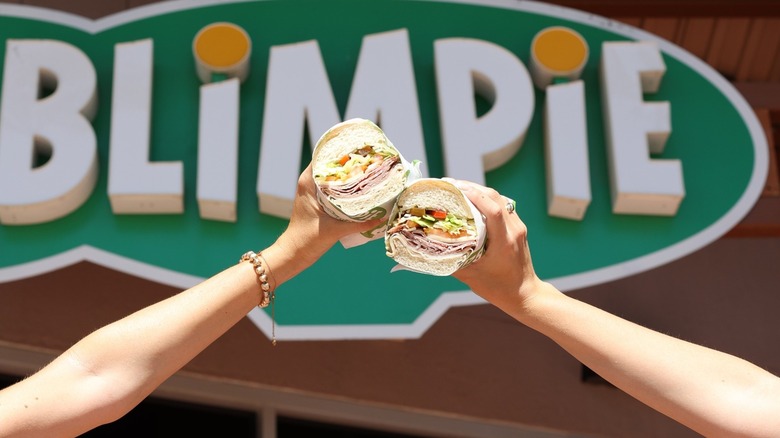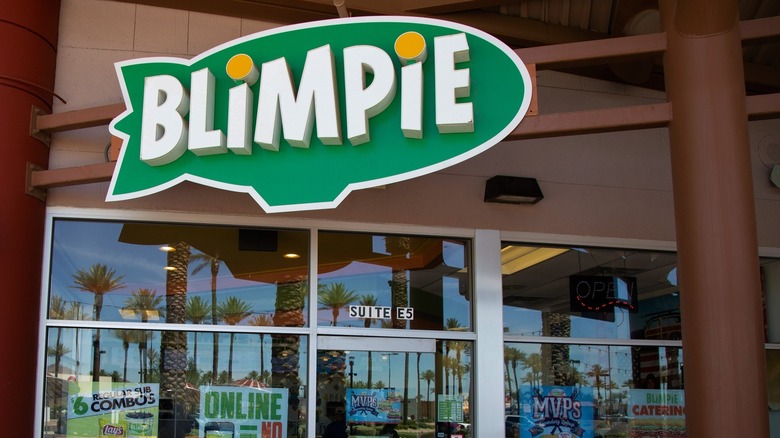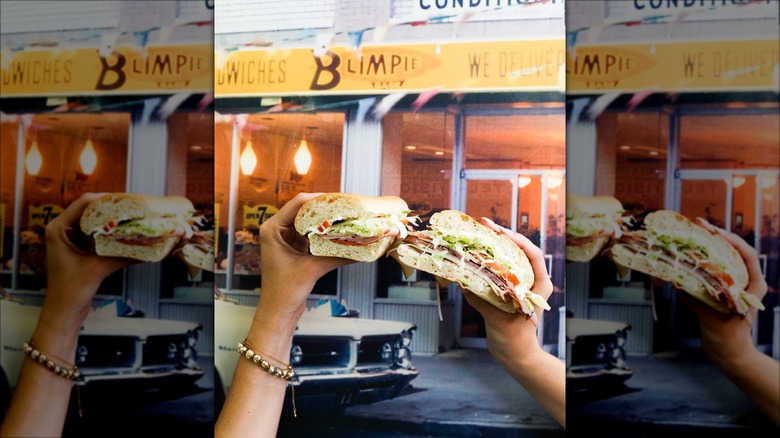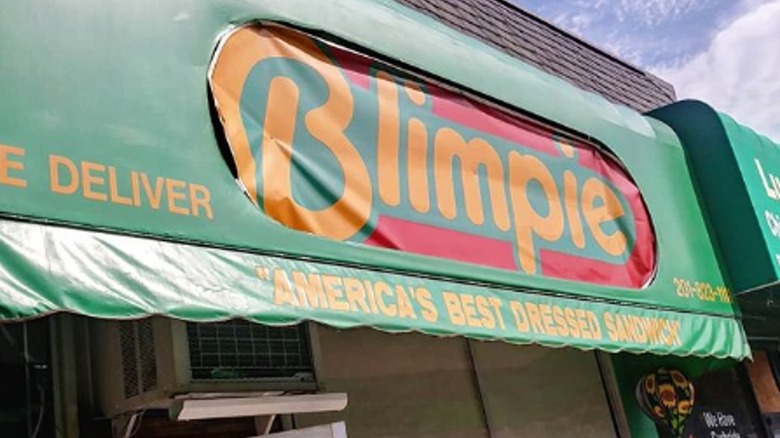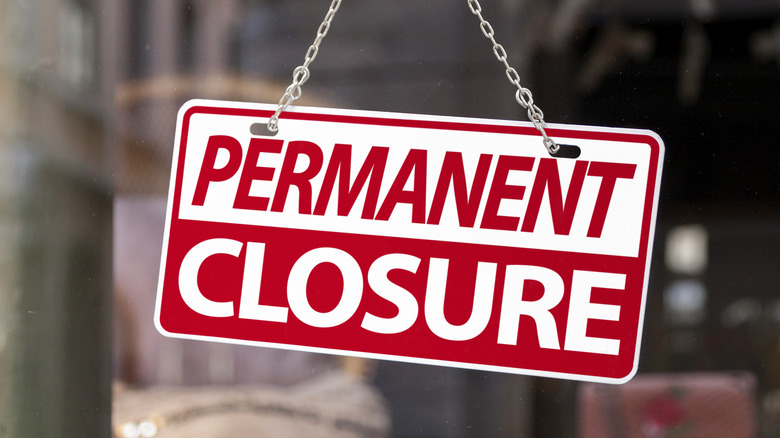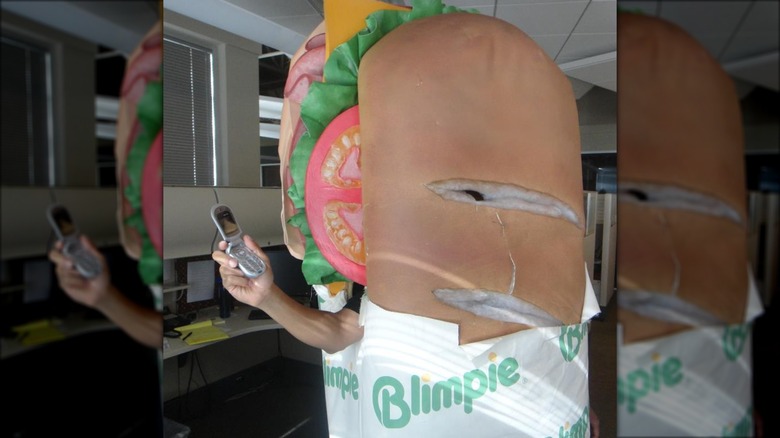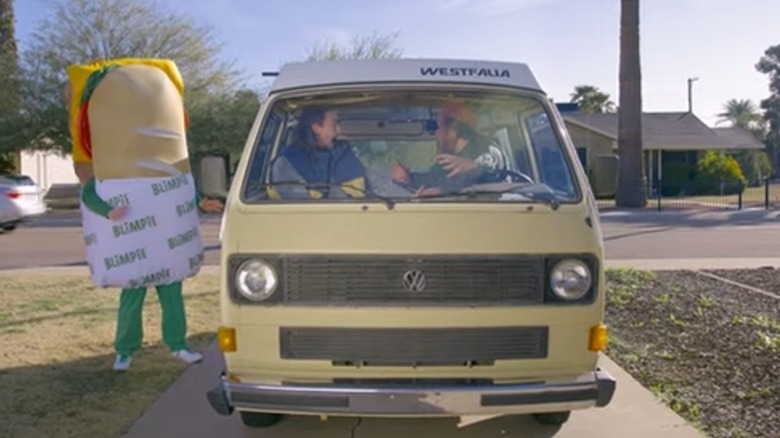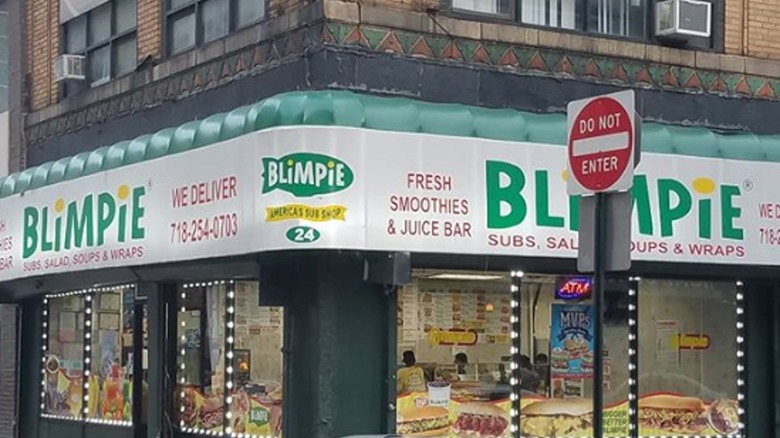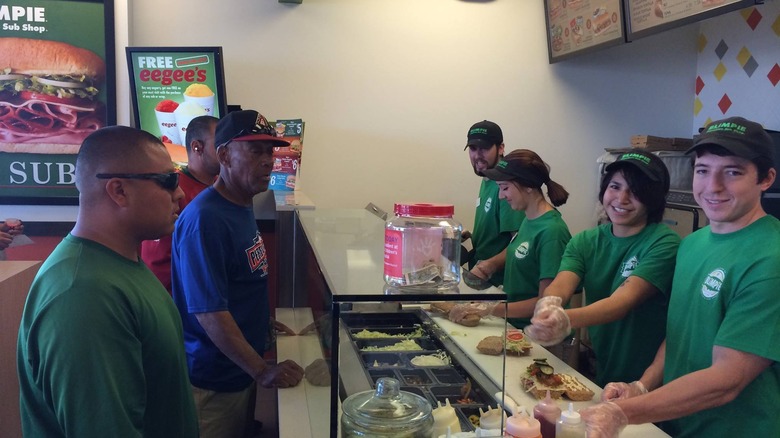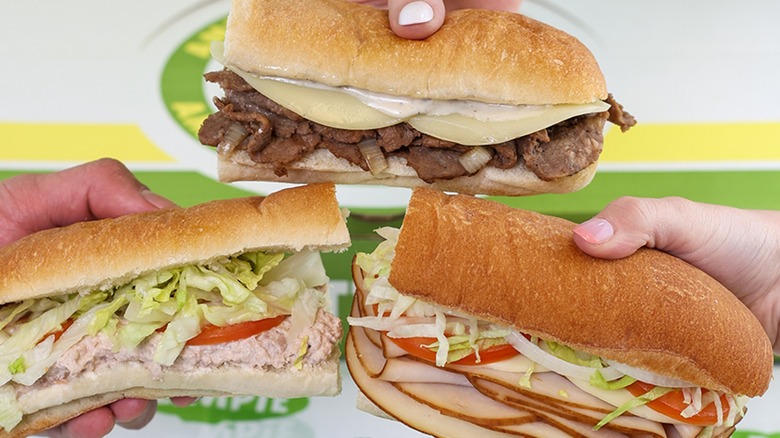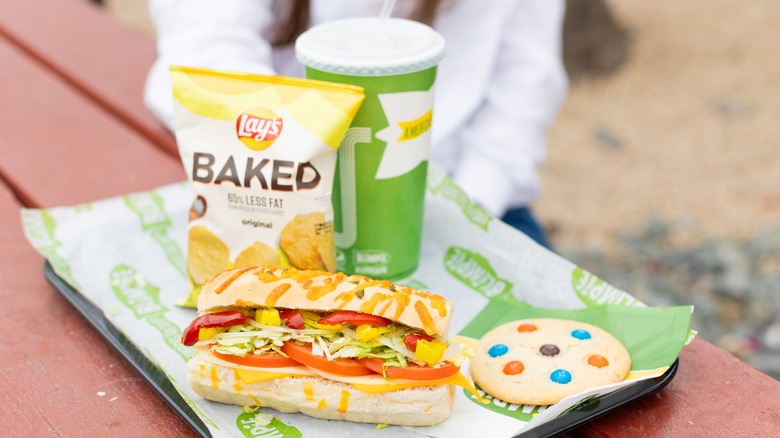Why Blimpie Is Struggling To Stay In Business
While many of us haven't seen a Blimpie in years, it turns out that it still exists, but it's struggling to stay afloat. There are so few locations now (often just in gas stations) that it would be easy to think it no longer exists. The truth is that it's been in freefall since the early 2000s. It's still hanging on, and we'd love to see it make a miraculous comeback. However, it will have to overcome a lot of missteps to bounce back to the place it once was.
The restaurant is going to have to make some major changes to bring itself from the brink of death. Blimpie has a lot of sub sandwich shop competitors that are thriving and could be inspired by. A lot of its problems relate to marketing, menu issues, and a failure to keep up with the times. However, some of its other problems go back to bad sales and partnership decisions. While we'd love to see Blimpie make a glorious return, it needs to address all the reasons it's struggling to stay in business first.
Lots of people don't know it still exists
If you thought Blimpies all disappeared years ago, you're not alone. There are fewer around and many states have only one or none at all. Plus, the ones that do still exist may be in a gas station, so the locations aren't always very prominent. So, you'd be forgiven for thinking it doesn't exist anymore. Even if you pass through a city that still has one or even live a couple of towns away from one, you can easily miss it.
In a subreddit for the "30 Rock" TV show, a Redditor said, "I just learned that Blimpie is a real fast food chain. There's only one in my state and it's in a small town 42 miles away. I thought it was made up for the show." Another Redditor said they didn't know Blimpies was real until their employer gave them a gift card to one. However, since the nearest one was two hours away, it might as well have been an imaginary restaurant.
If a restaurant is so covert and rare that people think it doesn't exist or that it's a fake restaurant, you're doing something seriously wrong with your advertising and promotion. While there were advertisements everywhere from TV to radio to newsprint back in the 1990s, you don't really see them anymore. However, we certainly know about its competitors like Subway and Jimmy John's.
Its location numbers have dwindled significantly
Several chain sandwich shops are disappearing around the U.S., and Blimpie is among them. If you once had a Blimpie in your town, it was probably back in its heyday in the 1990s and early 2000s.
Back in 1995, Blimpie locations were opening up right and left to the tune of 45 new ones each month. By 2001, there were 1,853 locations around the world, with some states having more than a hundred locations. So, you couldn't miss them. By 2011, there were only 739 stores left. We found reports of about 200 locations left in 2023. However, if you count the number of locations listed on the Blimpie app, there are only 85 left as of February 2024. That's more than a 95% decrease in location numbers in a little over 20 years.
You can find Blimpies open in 23 states across the U.S. The majority are in Virginia (4), New York (6), Michigan (6), Idaho (7), Georgia (10), and New Jersey (22). It makes sense that there would be more in New Jersey since the state is the chain's home. The first one opened in Hoboken, New Jersey, in 1964. Sadly, there are no more Blimpies in Hoboken as of 2017. It's a shocking development when a chain can't survive in its hometown.
It's never been the same since its sale in 2002
Blimpie's sale in the early '00s marks when its numbers started dwindling and sales started declining. At its height in 2001, it had 1,853 stores and was doing $300 million in sales per year. However, that success did not last.
The Blimpie downfall started in 2002 when co-founder Tony Conza sold the chain to a private investor group headed by Jeffrey Endervelt. As a Blimpie franchise owner, Endervelt was familiar with the company. While Conza was part of the investment group that bought the company, he moved down into an emeritus role.
By the time Kahala bought the chain in 2006, it had already lost over 200 locations. Nation's Restaurant News revealed that, within a year after its sale to Kahala, the chain lost 5.41% of its locations. During the second year of its ownership, it lost an additional 20.14%. It turns out that Kahala also owns several other franchise companies like Pinkberry, which are also struggling to survive. So, perhaps it wasn't the best sales decision. According to USA Today, in the 10 years between 2001 and 2011, 60.1% of the Blimpie locations closed and its sales declined by 60.4%. By 2011, it was only making $115.3 million a year. By 2022 (the last year we could find profits records), profits dropped to $63 million a year, with only 85 locations remaining by 2024. That's a drop of 79% in profits in a little over 20 years.
It has a high failure rate
Blimpie restaurants just haven't proven to be a good investment as it stands today. Even when there were still hundreds instead of just tens of restaurants open, it had a high small business administration (SBA) loan default rate. SBA loans are the ones that optimistic new franchise owners often take out to cover buying the property or to help with startup costs. Unhappy Franchisee reported that, between 2001 and 2015, 46% of people who got SBA loans for Blimpie locations ended up defaulting on them. With even fewer locations staying open as the years have progressed, it's likely that figure has only worsened.
With so many locations closing, it's a gamble to put personal assets (like a home) up for collateral when there's a high likelihood of a new Blimpie going belly up. Since a new franchise owner needs to invest $74,780 to $524,325 depending on the size and type of restaurant they want to open, it's a lot to lose.
Its attempts to target younger generations haven't been on point
Blimpie has tried a few times to (unsuccessfully) appeal to younger generations. Back in 2011, when Blimpie started going into full decline mode, the executive vice president of Technomic explained the phenomenon to 24/7 Wall St., saying, "[T]he contemporization of restaurants is creating a new breed, a new generation of restaurant in a competitive environment." He said older restaurants like Blimpie "have not kept up with current generations, or have been dominated by new competition within the segment." (via USA Today).
In 2005, Blimpie created a creepy, faceless sandwich mascot called Blimpie Guy. The $12 million Blimpie Guy campaign was an attempt to capitalize on a Blimpie appearance in a 2002 "Sex and the City" episode. The company did a $3 million campaign that year featuring Nascar driver Jeff Gordon alongside Blimpie Guy, hoping for a competitive edge with young adults between 25 and 44. The fact that the internet barely remembers Blimpie Guy is a testament to his failure.
Another attempt the chain made in 2013 for its 50th birthday was to offer a game to try to appeal to Millennials. The game, Blimpie Run, featured the Del E. Fresh mascot running around the U.S. collecting ingredients and trying to avoid obstacles like skunks. While it was possible to download it for Android or Apple phones and play for a chance to win free subs for a year, we can't imagine a lot of people did.
It doesn't get much social media engagement
Blimpie has jumped on the social media bandwagon ... kinda. It has Facebook, X (formerly known as Twitter), Instagram, YouTube, and TikTok accounts. In 2014, for its 50th anniversary, it tried to get more customers to engage with its social media profiles. Rather than hire an outside agency to help with social media, the company's director of digital media said they "sat around the table together, creating the marketing calendar and executing ideas" (via Retail Touch Points). The company was excited to see an increase in Facebook fans for its efforts. However, fan numbers mean very little if they never engage.
While Blimpie has 68,000 followers on Facebook, most of its posts are only getting tens of likes and a handful of comments or shares. People who do comment mention things like not having a Blimpie nearby anymore or having their local one closed because of staff shortages. Its Instagram account has 12,600 followers, with similar engagement patterns to Facebook, with people lamenting the lack of Blimpie locations nearby. It has almost 9,700 followers on X (formerly known as Twitter), but fewer than 100 people see each post with only one or two likes per post (if any). Clearly, it needs a new social media plan.
It's not using social media effectively
Just having social media sites and fans isn't enough if you're not using social media effectively. While it does have some social media activity, Blimpie needs a new social media marketing plan focused on what currently works on social media. Blimpie basically posts pictures or short videos of its sub sandwiches and hopes for the best. While photos of sandwiches can encourage cravings to get customers out the door and down the street to a Blimpie to buy one, one of the best ways to engage with customers on social media is through short, lighthearted videos.
The chain gave YouTube videos a go in 2018 and 2020. The two videos it released in 2018 got 81,000 to 275,000 views, while the two it made in 2020 had 309,000 to 580,000 views. Surely, they were onto something. However, for some reason, the chain didn't try making another video until January 2024 (with only a handful of views). It even tried posting a short on YouTube, but it's just a static ad with a picture of an Ultimate Roast Beef Sandwich. Boring. Nobody's sharing that. Blimpie finally has a TikTok account (with a little over 40 followers), but there are only six posts of food image videos. Meanwhile, Subway has over 635,000 followers on TikTok with new and interesting content and video plays that are often in the millions.
The menu has devolved since its early days
Blimpie's menu is extremely simple these days, which makes it easy to have small restaurants without a kitchen. But we're not sure the simple menu is necessarily working in the chain's favor. The menu currently has a dozen classic subs (like a Club) and premium subs (like Italian Beef) on the menu today, along with a couple of limited-time menu options (like the Ultimate Roast Beef). Plus, there are eight hot subs (like a Meatball Parmigiana). You can also buy chips, cookies, hot soup, or soft drinks to go with your meal. However, that's where the menu ends.
Recent diversification attempts have just been to offer different types of sandwiches. But there are no wraps, bowls, or salads for lower carb or gluten-free main-course choices, which other sandwich shops like Subway have. We're puzzled since it already has all the ingredients it needs to make salads or bowls. Earlier menus featured smoothies, juice, salad, and wraps in addition to what it sells today. It even promoted these options on its business signs. We're baffled as to why it hasn't brought these menu items back with more people looking for healthy menu options at restaurants now.
Many of the remaining ones are in places like truck stops
During Blimpie's early days, its locations were regular-sized restaurants. However, one new concept that Blimpie promoted to potential franchise owners in the 1990s was the idea of locations with smaller footprints that they could open in places like convenience stores, truck stops, malls, or college campuses. Aspiring new owners only needed $35,000 to get one started.
Since the restaurant doesn't cook meat or make bread or cookies on location, these smaller locations don't even need a kitchen. The chain even tried out a kiosk concept for places like special events and fairs, and movable display carts to sell sandwiches at airports or college campuses. Even in the remaining full-sized restaurants, there often aren't that many tables (maybe five or six). So, the restaurants aren't that optimistic about getting lots of customers.
However, all the signs point to this move not being the best direction the company could have gone. The idea was innovative and should have made the company more profitable with more locations. But that wasn't the reality, and the restaurant has become more invisible in the long run. Of course, having more small-scale restaurants is only a small piece of the full picture of what went wrong.
It has a lot of sub sandwich chain competitors that are doing things better
There are a lot of sandwich shop chains these days, but Blimpie sadly ranks toward the bottom. Theoretically, it should all be very profitable since the sandwich industry was worth $45.2 billion in 2023. In fact, according to IBISWorld, the sandwich industry is growing by 1.8% per year and should stay steady.
One reason sandwich shops are doing well is because of healthier options. However, it needs more than just healthy ingredients. It also needs a strong reputation, good locations (or any locations), continuous menu innovation, accommodations for special diets, and good marketing plans. Otherwise, it's not going to do well in today's market.
Some of the sub sandwich shop chains that are doing well and doing things better include Subway, Jimmy John's, Jersey Mike's Subs, and Firehouse Subs. The best example is Subway, which QSR named the "Transformational Brand of 2023." After six years of negative sales in the 2010s, Subway turned itself around with more digital sales strategies, getting serious about catering, reimagining the menu with curated sandwiches, and doing modern "Fresh Forward" remodels of its restaurants. Subway president Trevor Haynes told Nation's Restaurant News that its "priority remains working alongside our franchisees to find new and exciting opportunities to elevate the guest experience and drive profitability and traffic." The restaurant world has transformed dramatically in the past few years, leaving older chains in a position of needing to change or die.
It hasn't done much to set itself apart
Blimpie needs something to set it apart to get more business. When a city has several sub sandwich options, customers either go to the closest one or the one with something unique to offer.
One Redditor wanted to know whether Blimpie or Subway was the copycat chain. They noticed that Blimpie is "very similar to Subway from the bread selection, to how the meats and veggies are organized. The colors of the menu are similar and they both have cookies displayed near the cash register." Blimpie opened its first location in 1964, which was a year earlier than Subway, so you could claim that Blimpie is the original. However, if you find that you've been copied, it's time to move on and be different in other ways.
Some things that set Blimpie apart in the past no longer exist. Blimpie axed its smoothies, wraps, and salads, while other chains added them with success. Another Redditor felt that Blimpie "went downhill when most locations got the pre-sliced meats. You can get a better sandwich at most bodegas." However, freshly sliced meats became all the rage when Jersey Mike's adopted the practice, causing Subway to jump on the bandwagon and start doing it, too. There are plenty of innovative ideas and menu items Blimpie could add to set itself apart, but it seems to be heading in the opposite direction.
It failed in Singapore in just three years
Blimpie headed across the Pacific to Singapore in 2020. While 2020 wasn't the best year for any restaurant to start up because of the COVID-19 pandemic, the chain didn't fold right away. Even though it only survived in Singapore for three years, the problem was with the company running it rather than the restaurant.
The owner of Blimpie made a partnership with Deelish Brands in Singapore, a company already running several fast-casual restaurants selling everything from burgers and woodfired pizza to chicken and waffles. The initial plan was to stagger the opening of five Blimpie locations between 2020 and 2025. Unfortunately, it didn't last that long. It seems that Blimpie chose the wrong company to partner with since Deelish started the process of shutting down operations in 2023. Not only did it close down Blimpie, but it also closed down other restaurants it was running in Singapore, like Fatburger, Buffalo's Express, and Buttrmilk.
